Chara, Beta Canum Venaticorum (β CVn) is a Sun-like yellow main sequence star located in the constellation Canes Venatici, the Hunting Dogs. With an apparent magnitude of 4.26, it is the second brightest star in the constellation, after Cor Caroli. Chara is one of our nearest visible neighbours, located only 27.53 light years from Earth. Together with the brighter Cor Caroli, it outlines the southern of the two dogs represented by Canes Venatici.
Star type
Chara is a yellow dwarf of the spectral type G0 V. Its parameters are similar to the Sun’s. It has a mass of 1.025 solar masses and a radius 1.123 times solar. With a surface temperature of 5,653 K, it shines with 1.151 solar luminosities. The star spins a little faster than the Sun, with a projected rotational velocity of 2.9 km/s. Its estimated age is between 5.3 and 7.1 billion years.
Chara was once suspected to be a spectroscopic binary, but observations have not confirmed this. The Catalog of Components of Double & Multiple Stars lists two companions: one at a separation of only 0.1 arcseconds and another at 76.2 arcseconds. The latter star has a visual magnitude of 9.0.
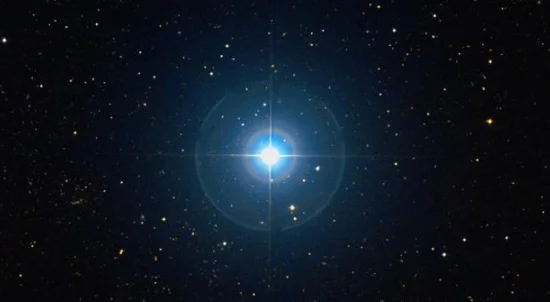
Chara (Beta Canum Venaticorum), image: Wikisky
Facts
Chara is one of the nearest Sun-like stars to the solar system, which makes it an interesting target for planet hunting missions. In 2006, American astronomer and astrobiologist Margaret Turnbull singled the star out as the top candidate to search for Earth-like extraterrestrial life by listening for radio signals from intelligent civilizations. No planets have been detected orbiting the star to date. Other stars on Turnbull’s SETI (Search for Extraterrestrial Intelligence) list were HD 10307, HD 211415, 18 Scorpii, and 51 Pegasi (host to the first extrasolar planet discovered orbiting a main sequence star).
Chara has been used as a stable anchor point for the Morgan-Keenan system of spectral classification since 1943. The MK system is used to classify stars based on the appearance of their spectra. Chara is a spectral standard for its class (G0 V).
Name
The name Chara (pronunciation: /ˈkɛərə/) is Greek for “joy.” It originally applied to the southern of the two dogs represented by Canes Venatici, but later came to be used for the constellation’s second brightest star. Canes Venatici represents the two hunting dogs held by Boötes, the Herdsman, as he pursues the Great Bear around the pole.
The name Chara was approved by the International Astronomical Union’s (IAU) Working Group on Star Names (WGSN) on July 20, 2016.
Beta Canum Venaticorum was also historically known as Asterion (“starry”). Asterion is the name of the northern dog of Canes Venatici.
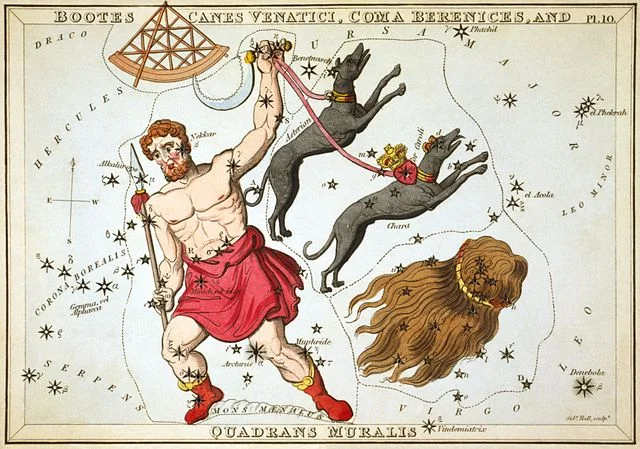
“Boötes, Canes Venatici, Coma Berenices, and Quadrans Muralis”, plate 10 in Urania’s Mirror, a set of celestial cards accompanied by A familiar treatise on astronomy… by Jehoshaphat Aspin
In Chinese astronomy, Chara is known as 常陳四 (Cháng Chén sì), the Fourth Star of Imperial Guards. The Chinese Imperial Guards asterism is formed by Chara with Cor Caroli, 10 Canum Venaticorum, 9 Canum Venaticorum, 6 Canum Venaticorum, 2 Canum Venaticorum, and 67 Ursae Majoris. The asterism is part of the Supreme Palace Enclosure, which represents the imperial court.
Location
Chara is relatively easy to find but, with an apparent magnitude of 4.26, it cannot be seen from heavily light-polluted areas. Cor Caroli and Chara lie directly below the handle of the Big Dipper. The imaginary line connecting the two stars is roughly parallel to the line connecting Alkaid and Mizar, the stars at the end of the Dipper’s handle. The brighter Cor Caroli appears south of Alkaid and Chara, below Mizar.
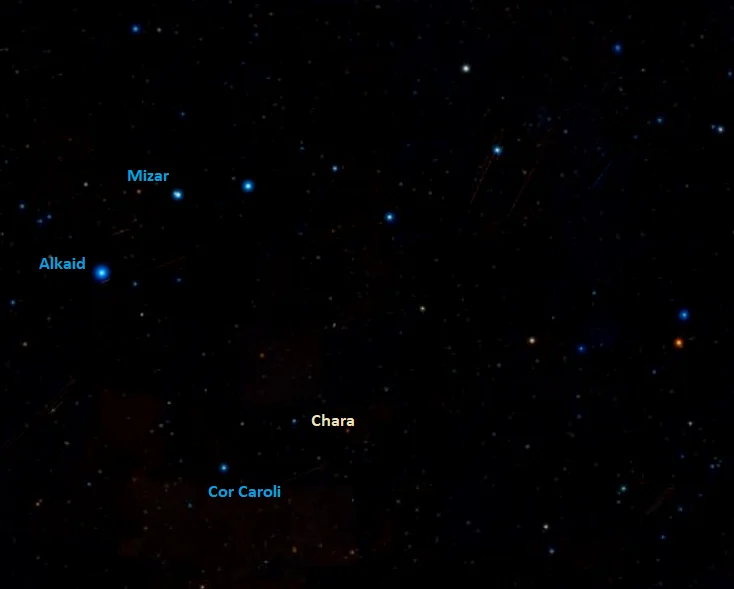
Chara location, image: Wikisky
Chara and Cor Caroli can be used to find Messier 94, a bright spiral galaxy located about 16 million light years away. The galaxy has an apparent size of 11.2 by 9.1 arcminutes and an apparent magnitude of 8.99. It appears above the imaginary line connecting Chara and Cor Caroli and forms a triangle with the two stars.
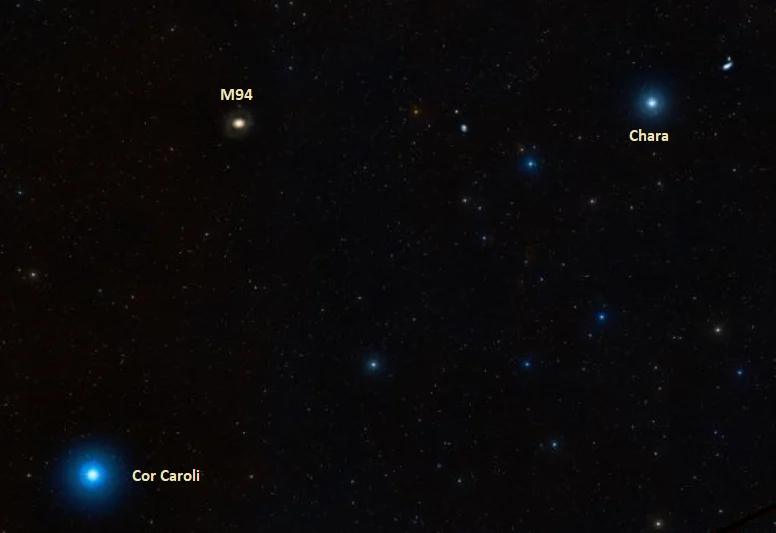
Chara, Cor Caroli and Messier 94, image: Wikisky
Several fainter galaxies appear closer to Chara. The distorted dwarf galaxies NGC 4625 and NGC 4618 lie east of the star. NGC 4625 is a peculiar spiral galaxy with an apparent magnitude of 13.2. It is interacting with NGC 4618, a distorted barred dwarf galaxy with an apparent magnitude of 11.2. Both galaxies have a single spiral arm, which gives them an asymmetric appearance.
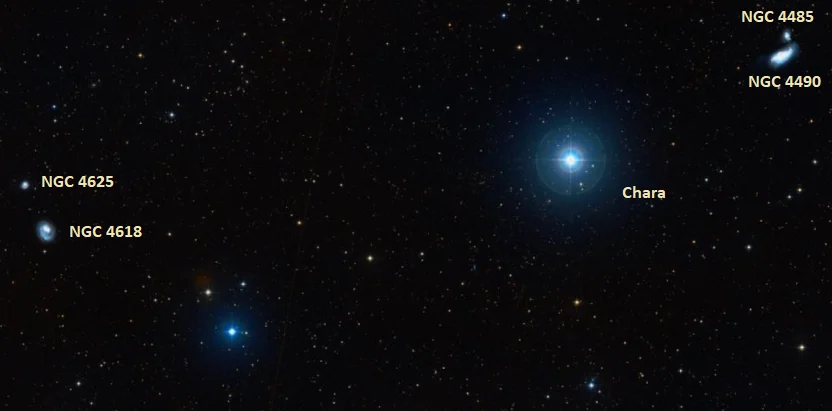
Chara, NGC 4490, NGC 4485, NGC 4618 and NGC 4625, image: Wikisky
The irregular galaxy NGC 4485 and barred spiral NGC 4490 appear northwest of Chara. The two make another interacting pair. As a result of their interaction, both galaxies are undergoing intense starburst activity. NGC 4485 has an apparent magnitude of 11.93 and lies 25 million light years away. NGC 4490, popularly known as the Cocoon Galaxy, has a visual magnitude of 9.8 at lies at a similar distance. The two galaxies are listed as Arp 269 in the Atlas of Peculiar Galaxies.
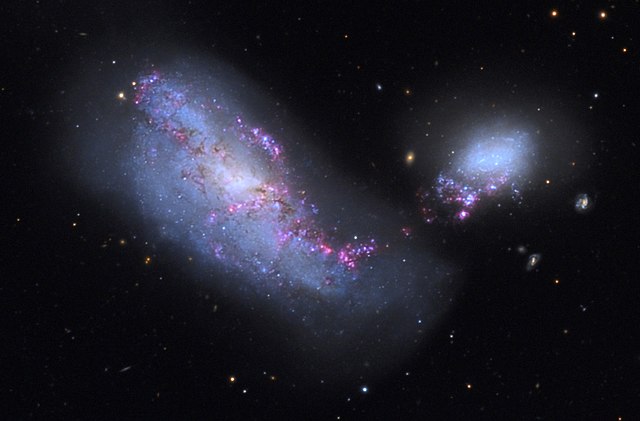
The Cocoon Galaxy (NGC 4490) and NGC 4485, image: Adam Block/Mount Lemmon SkyCenter/University of Arizona (CC BY-SA 3.0 US)
Constellation
Chara is located in the constellation Canes Venatici. Representing Asterion and Chara, the two hunting dogs of Boötes, Canes Venatici occupies 465 square degrees of the northern sky between the larger Boötes and Ursa Major. It is a relatively faint constellation, with only one star (Cor Caroli) brighter than magnitude 3.00. The constellation was created by Polish astronomer Johannes Hevelius in the late 17th century from faint stars under the handle of the Big Dipper (or the Great Bear’s tail).
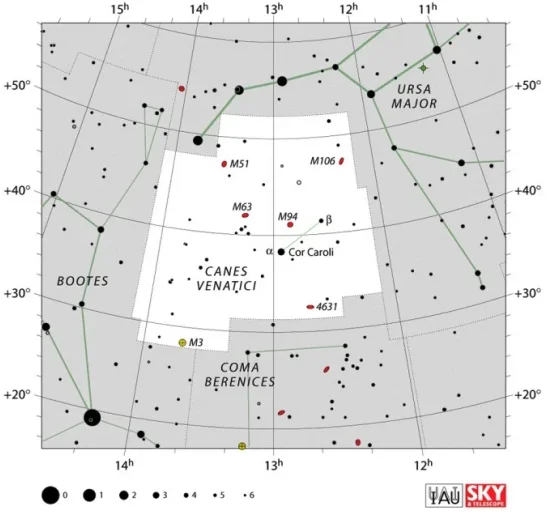
Canes Venatici constellation map by IAU and Sky&Telescope magazine
Even though it is fairly inconspicuous, Canes Venatici is familiar to stargazers because it contains several popular telescope targets. These include the bright globular cluster Messier 3, the galaxies Messier 51 (the Whirlpool Galaxy), Messier 63 (the Sunflower Galaxy), Messier 94, Messier 106, the Hockey Stick Galaxies (NGC 4656 and NGC 4657), the Whale Galaxy (NGC 4631), NGC 5033, NGC 5005, and the Big Lick Galaxy Group, a group of ten galaxies that includes the bright members NGC 5371, NGC 5353, and NGC 5350.
The best-known stars in the constellation include Cor Caroli, a prototype for its own class of variable stars, the carbon star La Superba (Y Canum Venaticorum), one of the reddest stars known, and RS Canum Venaticorum, a close binary star system that also serves as a variable class prototype.
The best time of year to observe the stars and deep sky objects in Canes Venatici is during the month of May, when the constellation is high in the evening sky. The entire constellation is visible from locations between the latitudes 90° N and 40° S.
The 10 brightest stars in Canes Venatici are Cor Caroli (Alpha CVn, mag. 2.81), Chara (Beta CVn, mag. 4.26), 24 Canum Venaticorum (mag. 4.68), 20 Canum Venaticorum (mag. 4.715), AW Canum Venaticorum (mag. 4.73 – 4.85), 5 Canum Venaticorum (4.767), 25 Canum Venaticorum (mag. 4.82), BH Canum Venaticorum (mag. 4.91), HD 115004 (mag. 4.94), and 6 Canum Venaticorum (mag. 5.01).
Chara – Beta Canum Venaticorum
| Spectral class | G0 V |
| U-B colour index | 0.04 |
| B-V colour index | 0.58 |
| Apparent magnitude | 4.26 |
| Absolute magnitude | 4.64 |
| Distance | 27.53 ± 0.05 light years (8.44 ± 0.01 parsecs) |
| Parallax | 118.49 ± 0.20 mas (Gaia: 116.1298 ± 0.6776 mas) |
| Radial velocity | 6.268 ± 0.0004 km/s |
| Proper motion | RA: -704.75 ± 0.13 mas/yr (Gaia: -716.246 ± 2.003 mas/yr) |
| Dec.: +292.74 ± 0.14 mas/yr (Gaia: 292.154 ± 1.643 mas/yr) | |
| Mass | 1.025 ± 0.050 M☉ |
| Luminosity | 1.151 ± 0.018 L☉ |
| Radius | 1.123 ± 0.028 R☉ |
| Temperature | 5,653 ± 72 K |
| Metallicity | -0.21 dex |
| Age | 5.3 – 7.1 billion years |
| Rotational velocity | 2.9 ± 0.4 km/s |
| Surface gravity | 4.60 cgs |
| Constellation | Canes Venatici |
| Right ascension | 12h 33m 44.5448195s |
| Declination | +41° 21′ 26.924857″ |
| Names and designations | Chara, Beta Canum Venaticorum, β CVn, 8 Canum Venaticorum, HD 109358, HR 4785, HIP 61317, SAO 44230, FK5 470, GC 17127, GCRV 7563, GJ 475, BD +42 2321, AG+41 1128, PPM 53064, JP11 2236, LHS 2579, LTT 13552, NLTT 31117, PLX 2895.00, LSPM J1233+4121, LFT 924, IRAS 12313+4137, UBV 11286, 2MASSJ12334454+4121270, USNO-B1.0 1313-00232014, TYC 3020-2541-1, Gaia DR2 1534011998570864256, WISEA J123343.91+412130.1, CCDM J12337+4121AB, WDS J12337+4121A, WDS J12337+4121Aa,Ab |